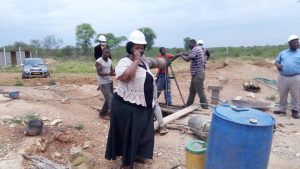

HAILING from a family of gold miners, Jane Lusinga’s stoic demeanour does not reveal the hardships she has endured over the years.

Most women in mining are in the small-scale sector and they experience a myriad of problems such as victimisation, physical, emotional and sexual assaults, lack of skills which is also exacerbated by lack of equipment due to lack of funding opportunities.
The 52-year-old woman looks with pride over what she has achieved at her two mines at Bubi District in Matabeleland North province, but behind that façade is a troubled soul that yearns for better living and working conditions for other female miners.
Lusinga’s journey into the lucrative, but often treacherous, mining sector began 17 years ago when her husband died.
“My life changed when l lost my husband. My salary as a teacher was not enough to fend for my family and I went straight to my father’s mine in 2004, after my short stay in South Africa, to learn the trade and cash up. My heart was filled with agony when I saw women gold panning with babies strapped at their backs,” she said.
In 2006 the mother of five was arrested together with tens of thousands of other miners during operation Chikorokoza Chapera that was aimed at curbing illegal mining.
However, this temporary setback did not affect Lusinga’s dream. In fact, the experience revived a boldness in her to stand up for women rights in the mining sector.
“My dream was to continue with my father’s legacy hence l was asked to apply for a certificate from the Environmental Management Agency (EMA) but the prices were exorbitant for someone who had lost a father who was my pillar of strength. I struggled but fortunately l was able to acquire the certificate and that’s how l got into mining,” added Lusinga.
 Despite a deadly accident in 2017 that took her three years to recover, she has not stopped helping other women miners who want to join the trade.
Despite a deadly accident in 2017 that took her three years to recover, she has not stopped helping other women miners who want to join the trade.
Lusinga, who is the regional chairperson for women in Matabeleland North province under the Zimbabwe Miners Federation, said while she is aware of the dangers of mining as a small-scale miner, she has never thought of quitting the trade.
“Women have been victims of sexual harassment, we are fighting against this stigma and most of the times it takes time for our paperwork to be processed and this is another problem,” she told this publication.
Her wish is to see women well capacitated with every necessary machinery as she believes this can change so many lives in the society.
Most women in mining are in the small-scale sector and they experience a myriad of problems such as victimisation, physical, emotional and sexual assaults, lack of skills which is also exacerbated by lack of equipment due to lack of funding opportunities.
“As a miner I would need to be educated on my rights and responsibilities in society and to be given knowledge on proper registration so that no one victimizes me,” Lusinga said.
The mining industry in Zimbabwe has been one of the economic pillars with women making up 10 percent of Zimbabwe’s 535,000 artisanal and small-scale miners. However, women face a number of challenges including sextortion in getting mining claims.
Experts say there is no legislation to protect women in mining when women’s contribution in the sector cannot be ignored. Chiedza Chipangura, founder of Norton Miners Association, said the existing discrimination against women often puts them at a lower order in policy decisions affecting them. She added that the sudden rush by almost everyone into mining has become a threat to women miners.
“With financial muscle, these people find it easier to boot out women out of their claims or overrun them,” she said.
“When miners show signs of violence, automatically as a woman you feel threatened and you can’t go out to a hotspot to mine there. As a result, you leave your claim for forfeit because there is that threat of violence. Mining is not really a safe space for women and we need laws to protect us during extraction.”
Chipangura added that challenges in accessing finance contribute to women’s inability to invest in mining equipment and technology necessary for a successful business.
“The other challenge is women cannot access funding because of the stringent conditions that are required. Let’s have mining rights bankable because most women don’t have collateral. To help the women flourish in mining there is a need for capacity building in terms of training,” she said.
Zimbabwe Environmental Law Association (Zela) project officer, Nobuhle Mabhikwa, said security for women was compromised in mining.
She said based on surveys that Zela carried out during the last wave of violence in 2019-2020, women were sharing that they feared for their lives and their safety and some felt there is no point in investing so much only to be killed in the end.
“In some areas we have women who actually stopped mining for a bit until they had to put in place security measures to protect themselves from the machete gangs,” Mabhikwa told The Financial Gazette.
“Women are still not yet safe and for some reasons, these machete gangs prey on mines that are owned mostly by women, maybe because they are more vulnerable compared to their male counterparts. In some areas that we work in, women have actually put-up security measures as preventive measures to help them deal with the machete gangs and violence that emanates from extraction,” she said.
She said when it comes to registration, women face challenges because mining is capital intensive and they need capital to be able to venture and successfully register their enterprises.
“So, the best thing they can do is to get loans. However, the challenge is that they cannot apply for those loans because in some cases they are required to provide collateral which they do not have. Its not easy for the women to embrace the opportunities that are shared as compared to their male counterparts,” Mabhikwa said.
“In terms of improvements, I feel we need to have a gender desk that focuses on women in the ministry of Mines, if possible, there need to be quotas or mining claims set aside for women and of course there still need to be more capacity building for women.
She applauded the School of Mines for deliberately creating opportunities for women so that they can build their capacity in mining adding that there is still more that needs to be done to make sure that the women can flourish.
“There is a need for the country to adopt a gender lens when it comes to policies and laws that govern the mining sector. That might deal with the challenges of participation of women in the artisanal mining sector. There is also a need to continuously showcase and support the women who are in the sector,” Mabhikwa said.
She said the country needs to adopt responsible sourcing policies in line with Organisation for Economic Co-operation and Development guidelines.

Winston Chitando, Minister of Mines.
Besides being exposed to harmful effects of physical and chemical dangers, women in mining areas, many women are excelling in the sector.
Mines and Mining Development minister, Winston Chitando, told a Chamber of Mines of Zimbabwe annual mining conference recently that gold producers need improved access to alternative sources of financing such as loans to boost production.
“In order to achieve the US$12 billion mining industry by 2023 target, the government is mainly looking at enhanced exploration and development of medium to large scale mines as well as capacitation of small-scale mines,” Chitando said.
The small-scale miners are currently contributing around 60 percent of all the gold that is being delivered to Fidelity Printers and Refiners.
Gold output during the first quarter stood at 4,311 kg compared to 6,152 kg produced in the same period in 2020 mainly on account of a fall in production from artisanal and small-scale gold sector.
Large scale producers delivered about 2,291 kg during the first quarter of 2021, 11,2 percent higher than what was produced during the same period in 2020, while artisanal and small-scale gold sector delivered 1,586 kg, about 55,6 percent below the production of the same period in 2020, reflecting leakages through smuggling according to Treasury.